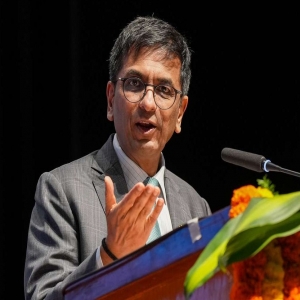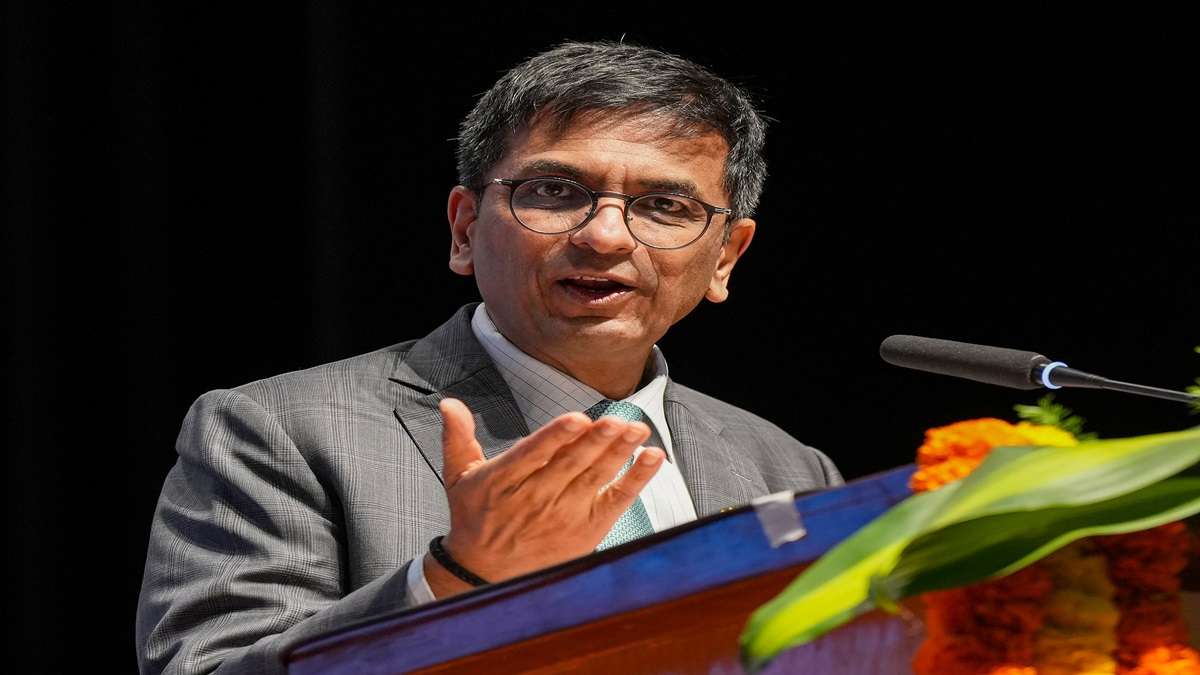
.jpg) Isaac Gomes
Isaac Gomes

On Saturday, June 29, 2024, Chief Justice of India (CJI) DY Chandrachud was in Kolkata for the National Judicial Academy Regional Conference. He made several candid observations (Bible for law students) while delivering his address on the topic 'Contemporary Judicial Developments and Strengthening Justice through Law & Technology.'
• "There is a need for inclusion and the ultimate pursuit of tolerance, which is why, 75 years after gaining our independence, we are still a nation with such beautiful diversity."
• "Too very often, we (judges) are addressed as Honour or as Lordship or as Ladyship. When people say that the Court is a temple of justice, there is a very grave danger that we perceive ourselves as the deities in those temples. I am a little reticent when I am told that this (courtroom) is a temple of justice. Because a temple postulates that judges are in a position of a deity."
• "I would rather recast the role of the judge as a server of the people. And when you (judges) regard yourselves as people who are there to serve others, then you bring in the notion of compassion, of empathy, of judging but not being judgmental about others allowing them to lead their lives as they wish." the CJI said.
• "Even while sentencing anyone in the worst criminal cases, the judges must do so with compassion, just as they do it with a sense of duty to the family of the victim who has been wronged. After all, a human being is being sentenced."
• "Above all, since we are judges, constitutional morality reflects an institutional commitment of the Court's system. We are subservient to the values of the Constitution. These concepts of Constitutional morality are the keys not just for the judges of the Supreme Court and high courts but also for the district judiciary because the engagement of common citizens begins first and foremost with the district judiciary. The Supreme Court is the Court of last resort notwithstanding Article 32."
• "The second aspect which I wanted to dwell on is why technology? What is the relevance of technology to common citizens? Our mission towards technology, especially in the E-Court of the Supreme Court which I have chairing for the last five years, is not to modernise the Indian Judiciary for the sake of modernisation. Modernisation is ultimately a step in aid of something else that we want to achieve (for common citizens). The government expends large funds on the modernising the Judiciary and in Phase-3 of the E-Courts project it has an outlay of Rs 7,000 crore. What is the purpose of this 7,000 crore to the lives of common citizens?"
• "Language is a central barrier to accessing justice and in understanding the work judges do. First, most of our textbooks are written in a language which is unknown to the common citizen. Mullah's Transfer of Properties Act, HM Seervai's Constitutional Law of India or DD Basu's Shorter Constitution of India all are written in English. How does the common citizen access the seminal words in these books which are meant for them? Technology provides us with some answers to these language problems. 37,000 judgements of the Supreme Court since independence have all been written in English. But these judgements deal with common citizens' problems, e.g. Women's Right to Maintenance, the right to seek bail of an accused who has been charged under section 498A, the right of a person who has been subjected to a very serious offence to ensure that the offender is tried expeditiously. Now, technology has enabled us to translate the judgements which we are writing, and I'm glad we have been able to get over 51,000 Supreme Court judgements translated into every language recognised by the Constitution. We are using machine learning/artificial intelligence (AI) assisted software for translation. The aim of doing all these translations is to take the work of the Court to the homes of common citizens. Our mission is on."
• "Another very important aspect is to access a judgement of the Supreme Court (and also of a high court), any young lawyer has to first and foremost subscribe to a law report. How many young lawyers can afford to spend, say, Rs 40,000-50,000 a year for the purpose of subscribing to a judgement of the Supreme Court? The judges deliver their judgements, but these are sold by private publishers! Is it not the duty of judges to ensure that the judgements delivered by them are available to the common citizen and lawyers? Because who appears for the common citizen? They are not the best lawyers sitting in Delhi, Kolkata, Mumbai or Chennai but the lawyers who belong to small farmers, workers and marginalised communities. Therefore, the Supreme Court has set in motion the digital Supreme Court Reports - a free resource on all Supreme Court judgements, made available in a digitised form on the Supreme Court website for lawyers and judges across India. This is an effort to promote legal literacy for young lawyers who have no resources to subscribe to these judgements."
• "After the language barrier, the second is distance. Most litigants cannot afford to visit Delhi or state capitals only to be informed of another date - 'tarikh pe tarikh.' That means we are ousting litigants from the process of justice in our courts. Video conferencing which was initiated during COVID-19 facilitates decentralised access to justice. What technology allows is access to our courts from remote locations. Why should access to High Courts or the Supreme Court be confined to one location? Is the Supreme Court the Supreme Court of Tilak Marg or the Supreme Court of India? We must open up access to our courts to lawyers and citizens across India."
• "Somebody who is in jail for months or years (he steered clear of UAPA), will the Supreme Court not look into it? Technology allows judges to listen to lawyers (who are closest to their clients) across India. That promotes a great deal of confidence in the Court's work when they realise that the smallest case of pension lost in bureaucratic apathy is being attended by the Supreme Court. A citizen is entitled to know with what seriousness the Supreme Court takes up his/her work."
• "The third important barrier is the lack of awareness of court procedures. A citizen doesn't know what procedures are involved between the time a case is lodged in the filings counter of the Supreme Court and the first hearing of the case. E-filing which we have adopted enables citizens to have streamlined access to justice. In the Supreme Court we have been able to establish a system whereby a case which is filed by a particular date shall be listed before the bench for the first hearing by a particular date. I am deeply concerned to learn that in many high courts even urgent applications for bail are not being taken up for hearing for months on end. This can't be the model for an ideal judicial system. We must give an assurance to a citizen that a case filed by a particular date will be put up for hearing by a particular date."
• "The National Judicial Data Grid is a mine of data on pending cases and disposed of cases. It goes down from the central level down to the last small Court in the Talukat. It has drilled-down features going down to the last case."
• "The greatest difficulty a plaintiff faces is in serving notice on the defendant who will be away from home to attend a marriage or elsewhere. There could be 20 different reasons why a summons cannot be served. Technology has given us a very simple solution in NSTEP. It's a simple phone app which works on a GPS which identifies the location of the process server. When the process is served on the defendant, it will log in by the means of GPS when it was served, takes a picture and logs it onto the server. Basically NSTEP Mobile App provided to bailiffs and process servers enable real-time tracking of service of notices and summons."
• "When Supreme Court grants a bail, how does one know whether the order has been implemented? It's not enough for a judge to lay down doctrines and pass an order. It's also his/her duty to ensure that the order has been implemented. For this, the Supreme Court has initiated a system called FASTER 2.0. It operates on the basis of Blockchain Technology (an advanced database mechanism that allows transparent information sharing within a business network). FASTER technology enables judges to check and ensure that the orders passed by them have been implemented."
• "People ask can AI be used to deliver judgements? AI can be used to make mathematical calculations to grant compensation but it will be naive to use it to deliver a judgement because it lacks compassion and empathy which a judge has despite his/her shortcomings. AI too has failings. It has biases depending on who has designed it. The Supreme Court is using AI in a different context. Cases including very high value ones, are filed in the Supreme Court registry. It has been noticed is that the most resourced of citizens are getting their cases fast-tracked while the cases of poorer citizens take a back seat. The Supreme Court is on the anvil of using AI to replace human intervention (in Supreme Court Registry) in the verification of defects e.g. court fee is not paid, every page not signed, annexures not properly printed. AI can identify these defects."
• "When a case comes before the Supreme Court, it is assigned a particular category (criminal appeals, Section 482 matters). Depending on categorisation, judges are earmarked. If a lawyer misstates the case categorisation, he/she can doctor the judge before whom the case will come. There have been instances in the Supreme Court where a wrong case categorisation has resulted in judge A getting a case instead of judge B. It's not always a case of mistake when the stakes are very high. AI can be used to read the entire case rapidly to at least give a preliminary case categorisation. This will help a lot to streamline cases."
• "The last point is on judgment writing. Our efforts should be to write our judgements in as simple language as possible without the use of unnecessary legal jargon."
• "Coming back to constitutional morality, increasingly judges are writing their own ideologies (pro-landlord or pro-tenant, in favour/against inter-faith marriage or consensual relationships outside marriage) in judgements. Instead of giving vent to their personal views on how one should live one's life in a society, judges should stick to the values (equality, fraternity, liberty, respect for all and inclusion of all) enshrined in our Constitution. They are servants of the Constitution but not its masters. Therefore they must refrain from imposing their personal views (perception of a just society or the way one should live) while writing their verdicts."